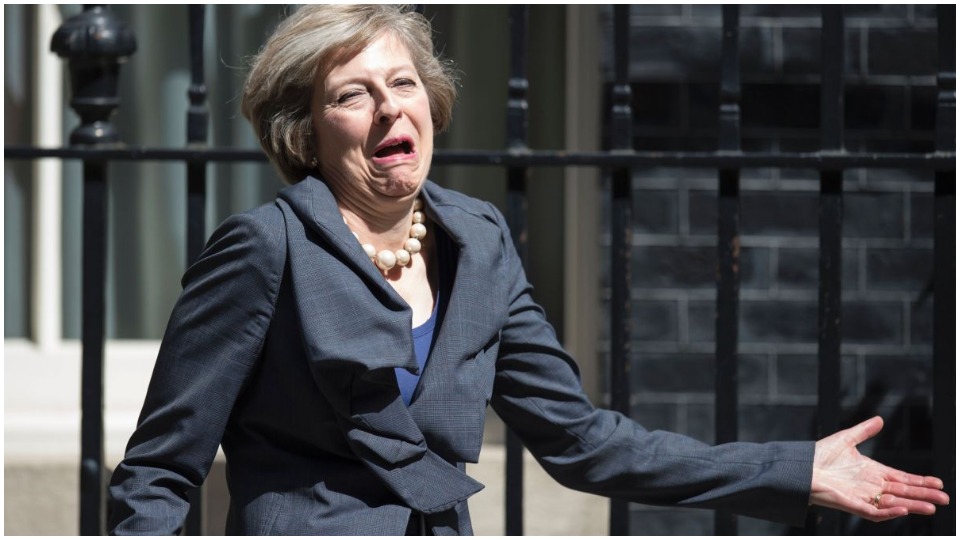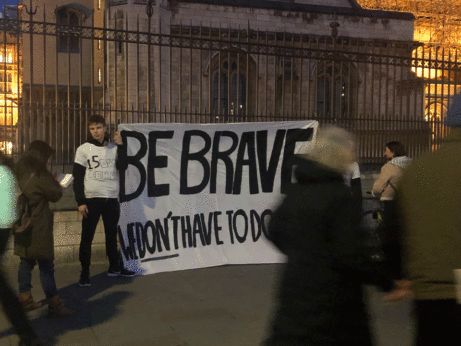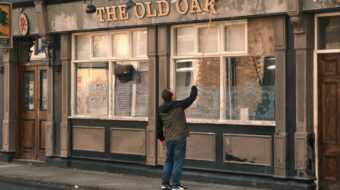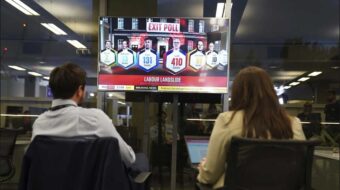
People’s World correspondent Al Neal is reporting from Europe during Britain’s supposed departure from the European Union, originally scheduled for March 29. With the developments of the last couple of days, that timeline is now in question. His earlier coverage of Brexit is available here.
LONDON— The streets outside the Houses of Parliament flooded with pro- and anti-Brexit demonstrators, press, and unsuspecting tourists frantically snapping photos of the scene before them—confused as to what had happened 10 minutes earlier.
Police clad in bright yellow neon vests lined the fenced sidewalk, strategically blocking the public from storming onto the Palace of Westminster’s grounds. The shouted order of “Make room!” cut through the noise as Members of Parliament drove out of the gated car park, some chauffeured, while others drove themselves.
“Traitors….Traitors….Traitors!” shouted pro-Brexit demonstrators as they surrounded MPs’ cars. The white and red flag of England, emblazoned with Saint George’s Cross, was held high, whipping in the wind.
The cries of “Brexit now!” rose and fell as they marched by anti-Brexit, pro-European Union supporters crowded together quietly holding up several blue and gold EU flags. A white and black banner held by youth activists read, “BE BRAVE: We don’t have to do this,” referring to the country’s departure from the EU.
After three days of heated debates in the House of Commons and 48 hours after British Prime Minister Theresa May’s deal was rejected a second time, MPs, in an unexpected twist, approved the government’s motion to ask for an extension of the EU divorce timeline 412 votes to 202 votes.
The extension would last until June 30, 2019—if May’s deal is approved by the House of Commons by Wednesday, March 20. A third meaningful vote. A move ignoring the dictionary definition of “meaningful.”
If her deal is not approved, then the length of the extension will be determined by its intended purpose—a condition likely required by the European Council as it considers whether to approve or deny the U.K.’s extension request.
However, it is still technically possible that the U.K. could leave the EU on March 29, as the law has not so far been changed.
Debates on the question to ask the EU for an Article 50 extension began at 10:30 a.m. and were scarcely attended by Conservative MPs. Sitting above in the public gallery were only a handful of observers, including this reporter.
At noon, Speaker of the House John Bercow selected four amendments, including the government’s motion, and a manuscript amendment filed by Labour MP Lucy Powell. Bercow had barely taken his seat when the chamber erupted in protest. The speaker, out of all the amendments filed, selected one calling for a second referendum (public vote) on Brexit but did not select the one that would take the second public vote option off the table.
The heated back and forth, lasting 30 minutes, was followed by several hours of backbench MPs giving their statements and opinions on the day’s question and the entire U.K./EU divorce process.
Behind the scenes, May faced outright rebellion from her Conservative Party, with many questioning whether she was “really in power.” Her former policy advisor, Conservative MP George Freeman, said the best way to get the current divorce agreement to pass is for May to resign.
At 4:50 p.m., MPs began filling the open chamber benches. The vote countdown was coming to a close. May took her seat, looking exhausted. Her eyes were almost swollen shut. It was the twelfth and final round inside the Brexit boxing ring. Meanwhile, Labour leader Jeremy Corbyn sat opposite of her looking fresh and ready for another round.
Bercow rose from his seat at 6:24 p.m. and gave the results: “The ayes to the right 412, the noes to the left 202…so the ayes have it, the ayes have it.”
The now overcrowded public gallery collective gasped as the result was announced. A brief silence settled in as “point of order” was given to Corbyn, now standing at the dispatch box.
“After the last few days of government chaos and some defeats, all of us now have the opportunity and the responsibility to work together to find a solution to the crisis facing this country, where the government has so dramatically failed to do so,” Corbyn said.
The Labour leader made it clear the PM’s responsibly was to accept that her deal and a “no-deal” Brexit were both defeated and “simply not viable options.”
Corbyn continued: “Tonight, I reiterate our conviction that a deal can be agreed based on our alternative plan that can command support across the House. And I also reiterate our support for a public vote not as political point-scoring but as a realistic option to break the deadlock.”
Boos and jeers from both sides of the chamber erupted immediately after his last sentence. The motion to hold a second referendum, Amendment H, had been defeated earlier 334 votes to 85, along with Labour’s amendment.

“Our job is to try to meet the concerns of the people who sent us here in the first place,” Corbyn said in closing.
European Council President Donald Tusk said he supported the idea of a complete rethinking of the negotiation process.
Tusk tweeted: “During my consultations ahead of #EUCO (EU Council meeting), I will appeal to the EU27 to be open to a long extension if the UK finds it necessary to rethink its Brexit strategy and build consensus around it.”
No one knows for certain what a rethinking of the Brexit strategy would be, but it could possibly include a U.K. general election. Restoring political trust with voters by changing the country’s top leadership is a move that members of all parties have advocated.
Will the remaining 27 EU nations approve a timeline extension? Maybe.
But as Michel Barnier, the EU’s chief negotiator, bluntly said, the U.K. needs to show a “constructive majority “ for what it wants from future relations with EU.
“It is the responsibility of the United Kingdom—they have to tell us what it is they want for our future relations, what will their choice be?” he continued. “That is the question that we need an answer to now.”
Brexit, along with British voters, now hang in limbo, leading many to ask, “What the hell comes next?”












Comments